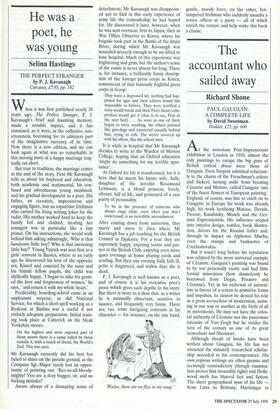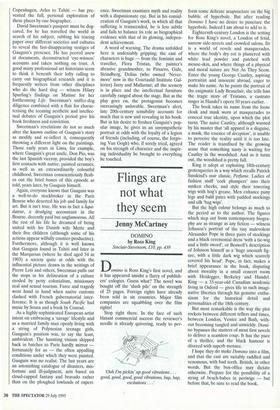The accountant who sailed away
Richard Shone
PAUL GAUGUIN: A COMPLETE LIFE by David Sweetman Hodder, £25, pp. 600 At the notorious Post-Impressionist exhibition in London in 1910, almost the only paintings to escape the big guns of British critical abuse were those of Gauguin. Even Sargent admitted reluctant- ly to the charm of the Frenchman's colour and Sickert, turning aside from berating Cezanne and Matisse, called Gauguin 'one of the finest flowers of European painting'. England, of course, was late to catch on to Gauguin; in Europe his stock was already high, his work fertilising Matisse, Derain, Picasso, Kandinsky, Munch and the Ger- man Expressionists. His influence seeped into interior design, textiles, book illustra- tion, decors for the Russian ballet and, through its impact on Alphonse Mucha, even the stamps and banknotes of Czechoslovakia.
But it wasn't long before his reputation was eclipsed by the more universal example of Cezanne. Gauguin's painting was found to be too personally exotic and had little formal innovation (how shamelessly he borrowed from Degas, Pissarro and azanne). Yet in his eschewal of natural- ism in favour of a return to primitive forms and impulses, he cannot be denied his role as a great accoucheur of modernism, assist- ing in one way or another at the birth of all its movements. He may not have the colos- sal authority of Cezanne nor the passionate intensity of Van Gogh but he strides the turn of the century as one of its great iconoclasts and liberators.
Although shoals of books have been written about Gauguin, his life has not attracted the minutely researched scholar- ship accorded to his contemporaries. His own copious writings are often gnomic and seemingly contradictory (though examina- tion proves him invariably right) and Holly- wood myth has blurred fact and fiction. The sheer geographical span of his life from Lima to Brittany, Martinique to Copenhagen, Arles to Tahiti — has pre- vented the full, personal exploration of these places by one biographer.
David Sweetman's passport must be dog- eared, for he has travelled the world in search of his subject, rubbing his tracing paper over different societies and cultures to reveal the fast-disappearing vestiges of Gauguin's presence. He has peered anew at documents, deconstructed 'eye-witness' accounts and taken nothing on trust. A good many professional art historians seem to think it beneath their lofty calling to carry out biographical research and it is frequently writers from other disciplines who do the hard slog — witness Hilary Spurling's findings on Matisse for her forthcoming Life. Sweetman's sniffer-dog diligence combined with a flair for charac- terising the teeming aesthetic and intellec- tual debates of Gauguin's period give his book freshness and conviction.
Sweetman's revelations do not so much alter the known outline of Gauguin's story as modify and re-inflect it, consequently throwing a different light on the paintings. Those early years in Lima, for example, where Gauguin's great uncle, Don Pio, was the last Spanish viceroy, provided the boy's first contacts with native, painted ceramics, as well as an extraordinarily colourful childhood. Sweetman conscientiously flesh- es out the brief bones of this episode. as told, years later, by Gauguin himself.
Again, everyone knows that Gauguin was a well-to-do stockbroker in the Paris Bourse who deserted his job and family for art. But it isn't true. He was in fact a liqui- dateur, a drudging accountant in the Bourse, decently paid but unglamorous. All the rest of his life he dreamed of being united with his Danish wife Mette and their five children (although some of his actions appear wilfully counter-productive). Furthermore, although it is well known that Gauguin found in Tahiti and later in the Marquesas (where he died aged 54 in 1903) a society quite at odds with the influential picture drawn in the writings of Pierre Loti and others, Sweetman pulls out the stops in his delineation of a culture eroded by petty colonialism, missionary zeal and sexual tourism. Farce and tragedy went hand in hand when native customs clashed with French gubernatorial inter- ference. It is as though South Pacific had music by Sousa and a book by Conrad.
As a highly sophisticated European artist intent on embracing a 'savage' lifestyle and as a married family man openly living with a string of Polynesian teenage girls, Gauguin's position was, to say the least, ambivalent. The haunting visions shipped back in batches to Paris hardly mirror fortunately for us — the often appalling conditions under which they were painted.
Gauguin was no realist. The last years are an astonishing catalogue of disasters, mis- fortune and ill-judgment, acts based on cloud-capped fantasy and bravado rather than on the ploughed lowlands of experi- ence. Sweetman examines myth and reality with a dispassionate eye. But in his consid- eration of Gauguin's work, in which all that suffering is transcended, he is less subtle and fails to balance its role as biographical evidence with that of its glowing, indepen- dent achievement.
A word of warning. The drama unfolded here is undeniably gripping; the cast of characters is huge — from the feminist and traveller, Flora Tristan, the painter's abrasive grandmother, to Pissarro, Gide, Strindberg, Delius (who owned 'Never- more' now in the Courtauld Institute Gal- leries) Jarry and Mallarmd; all the scenery is in place and the intellectual furniture carefully ranged about the stage. But as the play goes on, the protagonist becomes increasingly unlovable. Sweetman's alert, late 20th-century sensibility accounts for much that is new and revealing in his book. But in his desire to freshen Gauguin's pop- ular image, he gives us an unsympathetic portrait at odds with the loyalty of a legion of friends (including, of course, the forgiv- ing Van Gogh) who, if sorely tried, agreed on his strength of character and the inspir- ing individuality he brought to everything he touched.



















































 Previous page
Previous page